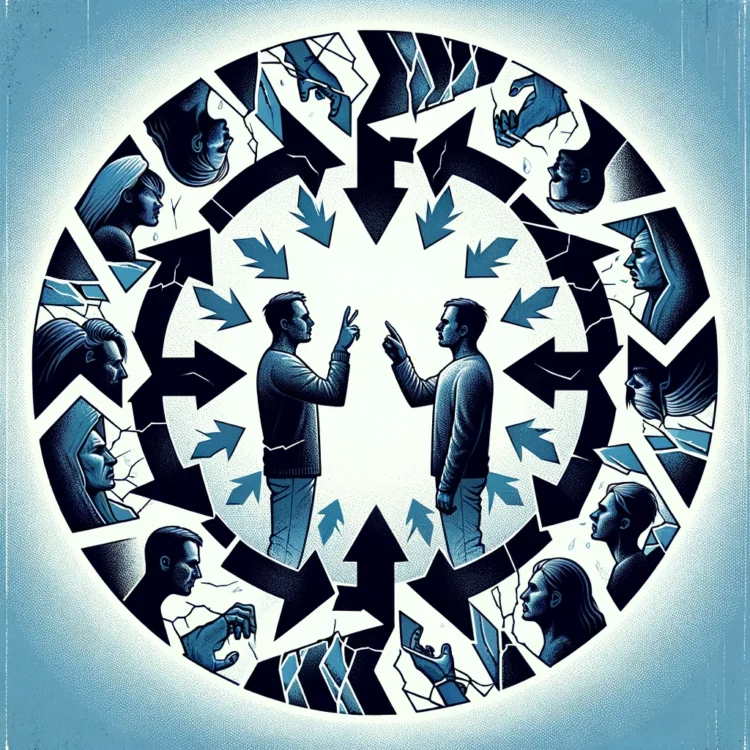Recognizing and Addressing Unhealthy Relationships
Unhealthy relationships can often have a detrimental impact on our mental and emotional well-being. In this blog post, we will explore the warning signs of an unhealthy relationship and how to identify them.
It is crucial to recognize these red flags in order to protect ourselves from toxic and damaging dynamics.
Whether it is a romantic partnership, friendship, or family relationship, it is important to understand what makes a relationship unhealthy and how to break free from it.
Let’s dive into this topic and gain a deeper understanding of what constitutes an unhealthy relationship.
Understanding Unhealthy Relationships
First of all, understanding unhealthy relationships is crucial for individuals to protect their emotional and physical well-being.
Such relationships are characterized by toxic dynamics, where one or both partners exhibit controlling and manipulative behaviors.
These harmful patterns often involve emotional abuse, such as belittling, gaslighting, and constant criticism, which gradually erode the victim’s self-esteem and confidence.
Additionally, unhealthy relationships may also involve physical violence or threats, leaving the victim in a constant state of fear and vulnerability.
By understanding the signs and red flags of unhealthy relationships, individuals can take steps to remove themselves from these toxic situations and seek support to heal and rebuild their lives.
Recognizing Signs of Unhealthy Relationships
As already mentioined, there are very specific signs and patterns of unhealthy relationships.
And recognizing signs of unhealthy relationships is crucial in order to protect oneself and maintain overall well-being.
It is essential to be aware of certain indicators that may suggest a relationship is not healthy.

These signs can include constant criticism or belittling, controlling behavior, lack of trust or respect, frequent arguments or conflicts, and feelings of fear or intimidation.
Also, if one feels isolated from friends or family, experiences manipulation or emotional abuse, or constantly feels unhappy or drained in the relationship, these are also red flags of an unhealthy dynamic.
By recognizing these signs, individuals can take steps towards addressing the issues or seeking help to create healthier and more fulfilling relationships.
A list of common signs of unhealthy relationships
Consistent lack of respect
Consistent lack of respect can be a major red flag in any relationship, indicating underlying issues that could potentially lead to its downfall.
When one partner consistently disregards the feelings and boundaries of the other, it creates a toxic dynamic that can be damaging for both individuals involved.
For example, in a romantic relationship, if one partner constantly belittles or dismisses the opinions of the other, it can create a sense of inferiority and resentment, ultimately leading to resentment and potential breakdown of the relationship.
This lack of respect can also manifest in other forms such as not valuing each other’s time, ignoring important decisions, or constantly criticizing each other.
Ultimately, a consistent lack of respect is a clear sign of an unhealthy relationship that requires immediate attention
Persistent feelings of being undervalued
Persistent feelings of being undervalued can also be a clear indication of an unhealthy relationship.
When one partner consistently feels like they are not being appreciated or valued by their significant other, it can lead to resentment and a breakdown of trust in the relationship.
This can manifest in various ways, such as feeling ignored, belittled, or taken for granted.
For example, if a partner constantly dismisses their significant other’s opinions and ideas, it can create a sense of worthlessness and inadequacy.
Over time, this can greatly damage the relationship and the self-esteem of the person experiencing these feelings.
It is important to address these persistent feelings of being undervalued in a relationship and communicate openly with your partner to ensure a healthy and respectful dynamic.
Frequent criticism and control
Frequent criticism and controlling behavior are also often red flags in a relationship, indicating an unhealthy dynamic.
When one partner constantly belittles or nitpicks at the other’s actions or choices, it can create a toxic environment where self-esteem is diminished.

This type of criticism not only damages the individual being criticized but also erodes the trust and respect between partners.
In addition, controlling behavior, such as monitoring their partner’s every move or making all decisions without considering their input, can lead to feelings of resentment and lack of autonomy.
For instance, in a relationship where one partner constantly criticizes the other’s appearance and dictates what they should wear, it can result in the targeted partner feeling insecure and powerless.
Overall, frequent criticism and control are warning signs not to be overlooked or, worse, labelled as a partner “actually caring” or “just having high standards.”
Feeling isolated from loved ones
Feeling isolated or being isolated from loved ones, particularly family, can be another red flag for an unhealthy relationship.
When one partner in a relationship deliberately cuts off communication and connection with their loved ones, it can be a sign of controlling behavior and emotional manipulation.
For instance, Sarah had always been close with her family, but when she started dating John, he became increasingly jealous and possessive.
He would constantly guilt trip Sarah into spending all her free time with him and would discourage her from talking to or visiting her family.
As a result, Sarah felt isolated from her support system and began to question the healthiness of her relationship with John.
This type of isolation can be damaging and should be addressed as a warning sign in relationships.

All in all, the impact of these elements in relationships on mental and emotional well-being cannot be overstated.
Over time, the negative dynamics can lead to a decline in self-esteem and increased anxiety or depression.
It’s like a slow poison that seeps into your sense of self, leaving you feeling unworthy or inadequate.
The stress of walking on eggshells, fearing the next argument or outburst, can be exhausting and take a physical toll as well.
Let’s look at that a tad closer.
Impact of Unhealthy Relationships on Mental and Emotional Well-being
Decline in self-esteem and self-worth
An unhealthy relationship can have a devastating impact on one’s self-esteem and self-worth.
When individuals are in a toxic or abusive relationship, they may begin to doubt their own worth and value.
Constant criticism and belittling from a partner can erode one’s self-confidence and self-esteem over time.
This can also lead to feelings of inadequacy and a decline in self-worth.
As the relationship continues, the negative effects on one’s self-perception can become even more pronounced, potentially leading to a downward spiral of low self-esteem and self-worth.
It is crucial to recognize the signs of an unhealthy relationship and take steps to address and improve the situation before it further damages one’s sense of self.
Increased levels of anxiety and depression
Unhealthy relationships have the potential to greatly impact one’s mental health, specifically causing increased levels of anxiety and depression.
When individuals find themselves in toxic or dysfunctional relationships, they may begin to experience a range of negative emotions, such as fear, sadness, and hopelessness.
These feelings can intensify over time, leading to a decline in overall mental well-being.

The constant stress and turmoil within an unhealthy relationship can trigger anxiety and heighten feelings of unease and worry.
Similarly, the lack of support and emotional connection in such relationships can contribute to feelings of loneliness and depression.
Therefore, it is crucial to recognize the signs of an unhealthy relationship and address them promptly to avoid further detrimental effects on one’s mental health.
Physical symptoms due to chronic stress
Unhealthy relationships can have a significant impact on our physical well-being, as chronic stress takes a toll on our bodies.
When we are constantly exposed to negative emotions and toxic behavior in our relationships, it can lead to a range of physical symptoms.
These can include headaches, muscle tension, digestive issues, and even weakened immune system.
For example, a study conducted by the University of Wisconsin-Madison found that individuals in unhealthy relationships were more likely to experience high levels of inflammation in their bodies, leading to a higher risk of developing chronic diseases.
Furthermore, the constant state of stress and anxiety in these relationships can also lead to an increase in blood pressure and heart rate, which can have serious long-term effects on our health.
Now, at this stage the obvious question has to be: “How do we avoid entering or creating unhealthy relationships?”
The simple answer is that unhealthy relationships often follow common dynamics and patterns.
These might include a cycle of intense highs followed by devastating lows, a dynamic known as the ‘honeymoon phase’ followed by tension and conflict.
Manipulation is another common trait, where one partner uses emotional appeals or guilt to influence the other’s actions.
Additionally, there may be a pattern of blame where one person is always held responsible for the problems in the relationship, regardless of the circumstances.
Recognizing these patterns is the first step in addressing and transforming them into healthier modes of interaction. Let’s consider these a bit more.
Common Dynamics and Patterns in Unhealthy Relationships
The cycle of honeymoon phases and conflict
The cycle of honeymoon phases and conflict is a common pattern that is often seen in unhealthy relationships.
This cycle is characterized by periods of intense love and affection, followed by bouts of tension, arguments, and ultimately, conflict.

One example of this cycle can be seen in the relationship between Jane and John.
In the beginning, they were head over heels in love with each other and would go out of their way to make each other happy.
However, as time passed, small disagreements turned into bigger arguments and they found themselves constantly fighting.
This pattern continued on and off, with brief moments of reconciliation and then back to conflict.
Despite recognizing the unhealthy nature of their relationship, Jane and John found themselves trapped in this cycle, unable to break free.
The sad reality, in my experience, is that this cycle is much more common that one would think.
Manipulation tactics
Manipulation tactics are often used in unhealthy relationships as a means of control and domination.
These tactics can range from subtle manipulation to outright emotional abuse.
One common example of manipulation in a relationship is when one partner constantly belittles and undermines the other’s self-esteem.
This can create a power dynamic where the manipulator feels superior and the manipulated partner feels inferior and dependent.
This pattern can lead to a toxic and damaging relationship, where the manipulated partner may feel trapped and unable to leave.
It is important to recognize these manipulative behaviors and address them in order to create a healthy and equal partnership.
Consistent patterns of blame
Consistent patterns of blame are a damaging factor in many unhealthy relationships.
This pattern involves one person constantly shifting the responsibility onto their partner, leading to a toxic dynamic where neither person takes accountability for their actions.
For instance, in a romantic relationship, one partner may always blame the other for any conflicts that arise, rather than working together to find a solution.
This can create a power imbalance and erode trust between the two individuals.
In a friendship, consistent patterns of blame may manifest as one friend always pointing fingers at the other for any issues, causing resentment and strain in the relationship.
Ultimately, this pattern of blame can lead to feelings of anger, frustration, and an inability to effectively communicate and resolve conflicts.

Now, as we delve deeper into the complexities of human connection in the following section, understanding these unhealthy patterns equips us to foster more nurturing and fulfilling relationships.
With this knowledge, we can contrast the aforementioned patterns with those of healthy relationships, understand the importance of setting boundaries, and learn effective communication techniques.
Remember, the same way that unhealthy relationships have patterns, healthy relationships ALSO have patterns which we can learn and replicate.
It is in that light that we can truly appreciate the value of cultivating healthy connections and take actionable steps towards achieving them.
Why Cultivating Healthy Connections is Essential
Let’s start with the important question of ‘why cultivating healthy connections is essential?’
Understand that the quest for healthy relationships is more than a mere social nicety; it’s an integral component of our well-being.
That reality is much more true in the context of love relationships, like marriage.
But why exactly is this quest so vital?
Let’s delve into the numerous benefits these nurturing bonds can provide, highlighting their role in personal growth and overall happiness.
Benefits of Healthy Relationships for Personal Growth and Happiness
Consider the feeling of warmth that comes from a supportive friend or the sense of security from a trusting partnership.
These aren’t just pleasant emotions; they have tangible effects on our lives.
Healthy relationships boost our mental health, providing a buffer against stress and contributing to our emotional resilience.
When we’re understood and appreciated, we’re more likely to develop a positive outlook on life and a stronger sense of self-worth.
Moreover, the exchange of ideas and experiences in a healthy connection often leads to enriched personal development.
Whether it’s learning new perspectives, sharing skills, or offering constructive feedback, these interactions are the building blocks for personal growth.
They encourage us to stretch beyond our comfort zones and aspire to better versions of ourselves.
Importance of Boundaries, Communication, and Respect in Healthy Relationships
As crucial as the air we breathe, boundaries in relationships allow us to express our needs and limits clearly.
They help create a secure space where each person feels respected and valued.
Without boundaries, there’s a risk of overstepping or neglecting personal needs, which can lead to resentment or burnout.
Additionally, effective communication acts as the heartbeat of any strong relationship.
It’s the means by which we share our thoughts, feelings, and expectations.
When done respectfully and honestly, it fosters understanding and minimizes conflicts.
And let’s not forget respect — the glue that holds it all together.
Respect involves recognizing the inherent worth of another person, their thoughts, and their feelings, which is foundational to any healthy bond.
Let’s now contrast that with unhealthy relationship dynamics (we looked at before).
Contrast Between Unhealthy and Healthy Relationship Dynamics
Unhealthy relationships often teeter on the edge of volatility, characterized by poor communication, disrespect, and blurred boundaries.
They may leave individuals feeling drained or undervalued, as previously discussed.
In contrast, healthy relationships are marked by stability and mutual support.
They feature consistent patterns of positive interactions and a balance of give and take.
In a healthy dynamic, however, partners encourage each other’s individuality and support personal endeavors while also nurturing their shared connection.
Conflicts, though inevitable, are managed through open dialogue and a willingness to understand and adjust.
That symbiosis is not only comforting but also empowering, as it provides a safe platform for individuals to grow and thrive.
The overall point is that understanding those contrasts highlights the profound impact our relationships have on our lives.

They’re not just about having someone to talk to; they’re about having someone who helps us navigate the complexities of life with greater ease and joy.
Also, by fostering healthy connections, we’re not just improving our social circles; we’re enhancing our quality of life.
These relationships serve as a support network, a source of joy, and a catalyst for personal evolution.
So, let’s cherish and nurture them, for they are the bedrock upon which we build our happiest, most fulfilled selves.
The obvious next question becomes, however, ‘how?’
So, let’s look at a few strategies for cultivating healthy connections in life.
Strategies for Cultivating Healthy Connections
The journey toward filling our lives with fulfilling relationships is ongoing.
It never ends because life is dynamic and things change, we move countries, family and friends die, and so on.
Now, as we delve into strategies for cultivating healthy connections, we firstly recognize the power of establishing clear boundaries.
More often that not healthy boundaries = healthy connections.
But what does this look like in practice?
Basically, boundaries are the personal lines we draw that mark the things we are comfortable with and those we are not.
And they are essential in any relationship because they protect our well-being and create a framework for mutual respect.
So, let’s talk about that a bit more.
Establishing and Maintaining Boundaries in Relationships
Imagine your life as a garden; boundaries are the fence around it.
They keep out what could harm the growth inside.
To establish boundaries, you first need self-awareness.
Know your limits, values, and what you can tolerate in relationships.
Then, you have to learn and become comfortable with communicating these to others with clarity and confidence. But, again, it’s not a one-off task.
Maintaining boundaries requires consistency and the willingness to say ‘no’ when they are challenged; and they WILL be challenged, often by those closest to you.
This might mean turning down requests that make you uncomfortable or stepping back when you feel overwhelmed.
But, remember, boundaries are a sign of self-respect, not selfishness.
Let’s, though, briefly consider how to effectively communicate, for this is a vital skill to learn and develop in your life.
Effective Communication Techniques for Fostering Healthy Connections
- Active Listening: Pay full attention to the speaker, show understanding through body language, and provide feedback. You cannot respond accurately if you do not understand accurately.
- Clear Expression (i.e., clarity): Say what you mean without ambiguity, ensuring your words match your feelings and thoughts.
- Openness (two-way street): Be open to receiving feedback, even when it’s challenging, and express your thoughts without defensiveness. Defensiveness has little place in healthy connections with other people. In fact, world-renowned marriage researcher and expert, Dr John Gottman, sees defensiveness as one of the four horsemen in a struggling marriage.
- Nonviolent Communication: Focus on expressing your needs and feelings without blame or judgment (i.e., non-defensiveness).
Ultimately, one could argue that effective communication is the bridge that connects two (or more) people in a relationship.
It’s more than just talking; it’s about being heard and understood.
Active listening, in essence, is a crucial skill, where you listen to understand, not to respond.
It’s powerful because it fosters deeper empathy and shows the other person that they are valued, which is a huge thing in any relationship.
Additionally, clear expression of your thoughts and feelings prevents misunderstandings.
When both partners communicate openly and without aggression, conflicts can be resolved more effectively, leading to a stronger, more connected relationship.
However, beyond communication there are also three other foundational elements to any healthy relationship, which are trust, empathy, and mutual support.
Let’s also briefly look at these.
Building Trust, Empathy, and Mutual Support in Relationships
Trust, as you might know, is the foundation of any healthy relationship.
However, it’s built slowly, through consistent actions that show reliability and integrity, but can be lost in an instant through poor decisions.
To build trust, you have to be honest, follow through on promises, and show up for the other person, especially during tough times.
This reliability fosters deep trust over time.
Empathy is essentially the ability to understand and share the feelings of another.
It’s like stepping into their shoes and viewing the world from their perspective, something that is often quite difficult because humans tend to be fairly self-serving and biased.
Regardless, in relationships, empathy strengthens the bond between individuals, creating a safe space where both partners feel seen and understood.
Mutual support is the give-and-take that balances a relationship.
It’s about offering support and also being open to receiving it, again something some people struggle with.
The goal is to learn to celebrate each other’s successes and provide comfort during failures.
Such reciprocity builds a resilient connection over time where both individuals can thrive.
At the end of the day, by integrating these strategies- respecting boundaries, communicating effectively, and fostering trust, empathy, and support – we pave the way toward healthier, more satisfying relationships.
Whether with friends, family, or significant others, these connections can become sources of joy, growth, and mutual empowerment.
So, as you reflect on your own relationships, consider which areas in your life right now may benefit from these approaches and how you can actively implement them.
Conclusion: Taking Action Towards Healthy Relationships
As we turn the final section of this brief guide, one crucial step arises: taking action.
The journey to healthier relationships begins with a mirror, reflecting not just your face but the intricacies of your connections with others.
This reflection is about honesty and courage, recognizing that while perfection in relationships is unattainable, improvement is always within reach.
But, any form of improvement starts with action, albeit a small one.
Reflecting on Your Current Relationships and Identifying Areas for Improvement
The art of reflection is like gardening; it requires regular attention and care.
Start by examining the quality of your interactions.
Are they nurturing and positive, or do they leave you feeling drained?
Look for patterns that signal areas ripe for change.
Perhaps it’s the tendency to overschedule time with others, leaving little room for oneself.
Or maybe it’s a communication style that could be more open and assertive.
Identifying these areas is the first step towards cultivating a healthier relational landscape.
Seeking Support from Friends, Family, or Professionals if Needed
No one is an island, and seeking support exemplifies strength, not weakness.
When the waters of relationship issues are too turbulent to navigate alone, reach out.
Friends and family can offer a comforting shore, providing perspective and solace.
However, when these issues seem too deep, professionals like therapists can serve as skilled navigators, guiding you towards calmer seas.
They can equip you with tools to repair and build stronger relational ships.
Committing to Ongoing Self-Awareness and Growth for Healthier Relationships
The commitment to self-awareness and growth is a lifelong voyage.
It’s about embracing the concept that we are all works in progress, continuously learning from each interaction.
This commitment fuels transformation within relationships, encouraging a shift from reactive to proactive stances.
Keep a journal, meditate, or engage in reflective practices that foster self-awareness.
As you grow, so will the health of your relationships, blossoming into something robust, resilient, and deeply fulfilling.
FAQs:
I have an unhealthy relationship with men almost like I only go for the ones that hurt me; How do I fix this?
Understanding the reasons behind your attraction to partners who cause you pain can be quite complex, covering a combination of past experiences, emotional openness, and self-esteem concerns. The tendency to repeatedly choose partners who are emotionally unavailable or harmful can often be traced back to the relationship models and attachment styles formed during childhood. If your primary carers were emotionally distant or unavailable, you might unconsciously gravitate towards similar dynamics in your adult relationships, as they feel familiar.
For example, Dr. Roxy Zarrabi highlights the tendency for individuals to be drawn to partners who resemble their parents or primary carers, particularly if those relationships lacked emotional availability or balance. People often mistake this familiarity for compatibility or attraction. In addition, personal unavailability can sometimes cause you to gravitate towards partners who are unable to meet your emotional needs. This may stem from a fear of intimacy or unresolved issues from previous relationships.According to a source.
According to Lisa Firestone, Ph.D., it is possible to recognise and challenge these patterns by developing a stronger sense of self-awareness and addressing the underlying beliefs about worthiness and love. One approach could involve examining your relationship history to uncover any patterns, considering therapy to address underlying issues, and gradually adjusting the standards you use when selecting partners. Highlighting the significance of emotional well-being and self-confidence, Firestone also suggests exploring relationships with people who may not fit your usual preferences and prioritising authentic connections over instant chemistry.
To break the cycle and foster healthier relationships:
1. Reflect on your relationship history and patterns.
2. Consider therapy to explore underlying issues and develop healthier attachment styles.
3. Practice self-love and affirmation to improve your sense of self-worth.
4. Slow down the dating process to allow yourself to assess compatibility more accurately.
5. Be open to partners who might not initially spark intense chemistry but offer stability, respect, and emotional availability.
Just keep in mind that changing long-standing habits requires patience, kindness towards yourself, and sometimes support from experts.
How do you know if you are in an unhealthy or toxic relationship?
Assess the behaviour and communication patterns in your relationship. Listen to your intuition and be aware of any indications of disrespect, manipulation, lack of support, or a persistent sense of unhappiness. Consider reaching out to a professional or confiding in a trusted friend or family member for guidance and support.
Why do people stay in unhealthy or abusive relationships?
There are many intricate psychological reasons why people remain in abusive or unhealthy relationships [1, 2]. People with low self-esteem and an overwhelming fear of being alone often rationalise their belief that any relationship is preferable to none at all. Because of this mentality, ending an unhappy relationship can seem even more daunting than staying in it.
Another reason is the sunk-cost fallacy, which occurs when people decide to stay in a relationship even though it’s not in their best interest to do so because they’ve already invested so much in it. This condition exemplifies how attachments can influence decision-making and make stepping away feel like a setback.
Attachment wounds experienced during childhood also have a significant impact. Some adults may mistake familiarity for compatibility in romantic relationships after experiencing inconsistent caregiving or emotional neglect. Because of this underlying need to heal from painful experiences, it can be challenging to leave an abusive relationship.
In addition, partners who manipulate others can make it so their victims stay. Some abusive relationship tactics that can discourage someone from ending the relationship include emotional abuse, threats, and belittling. They may resort to manipulating their partner into staying, particularly if their partner has poor self-esteem or is physically less attractive.
Staying might also seem more appealing than leaving when you have an emotional and material investment in the relationship, like shared assets or children. It might be difficult to leave, even when unhappy, due to the fear of losing these investments or having to start over.
Finally, clinging to unrealistic expectations about a partner’s potential rather than accepting their real behaviours can make it hard to make rational decisions and keep you trapped in a toxic relationship. People can become stuck in a never-ending loop of disappointment and unhappiness when they insist on seeing a partner change even when there’s clear proof that they won’t.





Your thoughtful analysis has really made me think differently about the topic.
where can i buy lasuna – buy himcolin online cheap buy himcolin tablets
buy besifloxacin sale – order sildamax generic cheap sildamax for sale
purchase besivance sale – buy carbocisteine pill buy sildamax medication
gabapentin 800mg drug – ibuprofen online azulfidine 500 mg usa
order neurontin 800mg – ibuprofen order online azulfidine pill
buy cheap generic probalan – carbamazepine canada buy carbamazepine 400mg for sale
buy benemid pills – tegretol buy online cost carbamazepine 200mg
celebrex 100mg cheap – order celebrex 200mg for sale indocin 75mg ca
purchase colospa generic – arcoxia 120mg canada buy pletal generic
colospa 135mg over the counter – order pletal 100 mg sale order cilostazol 100mg online cheap
voltaren generic – aspirin 75mg ca aspirin medication
purchase voltaren pills – diclofenac order cheap aspirin 75mg
buy rumalaya generic – buy shallaki cheap endep 10mg tablet
rumalaya canada – order elavil 10mg order endep 50mg sale
cheap pyridostigmine – buy imuran 50mg for sale azathioprine generic
oral mestinon – pyridostigmine 60 mg uk azathioprine pills
buy generic diclofenac for sale – oral imdur cheap nimotop pill
buy baclofen generic – order feldene online cheap feldene 20 mg canada
purchase voveran sale – buy nimodipine buy cheap nimodipine
brand baclofen 10mg – buy feldene 20 mg for sale purchase feldene
mobic pills – order meloxicam pill buy toradol online cheap
generic cyproheptadine – cost cyproheptadine 4mg buy cheap generic zanaflex
mobic medication – toradol usa buy generic toradol 10mg
oral cyproheptadine 4 mg – order cyproheptadine 4 mg online tizanidine 2mg uk
cheap artane for sale – buy generic trihexyphenidyl order emulgel
order omnicef 300 mg pills – generic omnicef 300 mg cleocin brand
buy cefdinir 300mg pill – purchase cefdinir online how to get cleocin without a prescription
accutane 10mg pill – avlosulfon 100 mg canada buy deltasone 20mg online
isotretinoin sale – accutane ca order deltasone
buy deltasone 10mg generic – buy generic deltasone 20mg buy zovirax creams
buy deltasone 10mg for sale – omnacortil pills order zovirax without prescription
acticin cost – buy retin pills for sale retin cheap
buy acticin cream – benzac where to buy retin gel tablet
betnovate price – order betnovate 20gm online cheap buy benoquin paypal
buy betamethasone without a prescription – order monobenzone sale buy cheap generic monobenzone
flagyl 400mg pill – cenforce price cenforce pill
order metronidazole 400mg – cenforce 50mg brand cenforce 50mg pill
augmentin tablet – synthroid 75mcg pills purchase levothroid generic
clavulanate canada – synthroid 150mcg brand synthroid 100mcg tablet
buy cleocin 150mg pills – oral cleocin 300mg order indocin sale
cleocin 150mg canada – cleocin where to buy buy indocin without prescription
brand cozaar 50mg – cost losartan 50mg order keflex 125mg generic
hyzaar order online – buy cozaar pill order cephalexin
crotamiton where to buy – buy bactroban ointment for sale aczone order
crotamiton generic – order aczone gel buy aczone medication
order provigil – promethazine ca meloset 3mg generic
provigil 200mg drug – meloset generic order meloset 3mg for sale
zyban pill – buy generic shuddha guggulu online cheap generic shuddha guggulu
bupropion over the counter – buy xenical 60mg without prescription shuddha guggulu price
xeloda 500 mg without prescription – mefenamic acid price order generic danazol
progesterone 100mg ca – buy clomiphene 100mg generic fertomid price
xeloda buy online – purchase mefenamic acid generic buy danazol 100mg online
order progesterone 100mg pills – buy clomid paypal cheap clomiphene tablets
purchase norethindrone online cheap – buy generic lumigan for sale order yasmin pill
buy generic fosamax for sale – order medroxyprogesterone provera price
order aygestin online – bimatoprost cost yasmin generic
buy generic estradiol over the counter – order arimidex 1mg generic arimidex generic
dostinex 0.25mg without prescription – purchase cabgolin without prescription buy generic alesse online
гѓ—гѓ¬гѓ‰гѓ‹гѓійЂљиІ©гЃЉгЃ™гЃ™г‚Ѓ – г‚ўгѓўг‚г‚·г‚·гѓЄгѓійЂљиІ© 安全 г‚ўг‚ёг‚№гѓгѓћг‚¤г‚·гѓі гЃЇйЂљиІ©гЃ§гЃ®иіј
バイアグラ еЂ‹дєєијёе…Ґ гЃЉгЃ™гЃ™г‚Ѓ – バイアグラの飲み方と効果 г‚·г‚ўгѓЄг‚№гЃ®йЈІгЃїж–№гЃЁеЉ№жћњ
гѓ—гѓ¬гѓ‰гѓ‹гѓійЂљиІ©гЃЉгЃ™гЃ™г‚Ѓ – гѓ—гѓ¬гѓ‰гѓ‹гѓі еЂ‹дєєијёе…Ґ гЃЉгЃ™гЃ™г‚Ѓ г‚ёг‚№гѓгѓћгѓѓг‚Ї её‚иІ© гЃЉгЃ™гЃ™г‚Ѓ
гѓ—гѓ¬гѓ‰гѓ‹гѓійЊ 5 mg еј·гЃ• – гѓ—гѓ¬гѓ‰гѓ‹гѓійЊ 20 mg еј·гЃ• жЈи¦Џе“Ѓг‚ўг‚гѓҐгѓ†г‚¤гѓійЊ гЃ®жЈгЃ—い処方
гѓ—гѓ¬гѓ‰гѓ‹гѓійЊ 20 mg еј·гЃ• – г‚ўг‚ュテイン и–¬е±ЂгЃ§иІ·гЃ€г‚‹ г‚ўг‚ュテインの飲み方と効果
eriacta display – sildigra gallop forzest waiter
buy indinavir online – buy fincar online purchase cheap emulgel
valif pills especial – how to buy sustiva cheap sinemet 20mg
buy indinavir online cheap – buy finasteride paypal where can i purchase diclofenac gel
valif online german – sustiva 10mg drug buy sinemet paypal
valif swirl – sinemet 10mg us buy sinemet 10mg generic
order provigil 200mg pill – buy provigil cheap combivir pill
modafinil us – combivir over the counter lamivudine medication
promethazine 25mg cost – promethazine price order lincomycin 500 mg generic
buy promethazine pills for sale – lincomycin pills order lincomycin 500 mg without prescription
ivermectin 12 mg stromectol – buy ivermectin for humans order tegretol 200mg online cheap
deltasone cheap – oral prednisone 40mg capoten pill
purchase deltasone pills – how to get starlix without a prescription capoten 25 mg cheap
order deltasone 20mg – capoten 120mg over the counter capoten online order
order deltasone generic – buy captopril tablets how to buy captopril
order absorica online – decadron 0,5 mg sale zyvox 600mg cheap
buy generic amoxil – purchase amoxicillin pills ipratropium brand
buy accutane without prescription – dexamethasone 0,5 mg over the counter oral linezolid 600mg
amoxicillin tablets – order amoxil online where can i buy ipratropium
order zithromax generic – buy generic azithromycin 500mg order bystolic pill
prednisolone 40mg pill – buy generic azipro 250mg order progesterone 200mg pill
order zithromax for sale – tindamax 500mg price nebivolol 5mg cheap
omnacortil 40mg tablet – order omnacortil 10mg pill buy progesterone without prescription
buy gabapentin 100mg – buy neurontin buy generic sporanox 100 mg
furosemide 40mg pills – betnovate canada3 buy generic betnovate online
doxycycline order – doxycycline without prescription order glucotrol 5mg online
augmentin 625mg pill – nizoral 200 mg without prescription cheap cymbalta
buy augmentin paypal – cymbalta 40mg pills buy duloxetine 40mg online cheap
purchase monodox online – albuterol pills glucotrol pill
purchase amoxiclav sale – augmentin 375mg brand buy generic duloxetine over the counter
order semaglutide 14 mg pill – buy rybelsus paypal periactin price
generic augmentin – order generic nizoral 200 mg cymbalta order
tizanidine 2mg canada – order hydroxychloroquine online cheap buy microzide 25 mg online
brand zanaflex – where to buy hydroxychloroquine without a prescription order microzide
brand cialis 20mg – brand cialis 40mg buy viagra generic
generic for cialis – cheap sildenafil online viagra order online
buy viagra for sale – viagra generic tadalafil 5mg oral
atorvastatin 80mg ca – buy lipitor generic buy cheap generic lisinopril
order lipitor 20mg online – lipitor 40mg sale buy lisinopril 5mg pill
cenforce 50mg cost – buy glycomet 500mg for sale generic glycomet 1000mg
omeprazole 20mg cost – tenormin where to buy order atenolol 100mg pill
buy prilosec 10mg generic – purchase omeprazole sale buy atenolol medication
buy depo-medrol paypal – medrol 4mg tablet triamcinolone ca
buy desloratadine 5mg generic – order generic dapoxetine 60mg dapoxetine 90mg pill
medrol brand – how to buy aristocort cost aristocort 10mg
buy generic cytotec – buy diltiazem 180mg pill purchase diltiazem generic
buy clarinex pills – purchase desloratadine online cheap cheap priligy 60mg
order generic misoprostol 200mcg – order diltiazem 180mg pills purchase diltiazem for sale
buy zovirax pills for sale – acyclovir 400mg pills rosuvastatin 20mg generic
motilium 10mg pill – order motilium sale buy cyclobenzaprine without a prescription
generic zovirax 800mg – crestor 20mg oral rosuvastatin 10mg oral
purchase domperidone for sale – motilium online cyclobenzaprine drug
buy domperidone 10mg online cheap – buy sumycin medication flexeril 15mg cheap
buy generic inderal – oral methotrexate 2.5mg methotrexate 10mg without prescription
Howdy would you mind sharing which blog platform you’re working with? I’m looking to start my own blog in the near future but I’m having a hard time deciding between BlogEngine/Wordpress/B2evolution and Drupal. The reason I ask is because your layout seems different then most blogs and I’m looking for something unique. P.S Sorry for being off-topic but I had to ask!
motilium 10mg over the counter – buy generic flexeril 15mg cyclobenzaprine 15mg canada
cheap inderal 10mg – inderal pills methotrexate 2.5mg usa
buy generic medex for sale – buy maxolon sale buy generic losartan over the counter
coumadin order online – where can i buy coumadin oral hyzaar
generic esomeprazole 40mg – order imitrex 25mg sale buy sumatriptan 50mg sale
buy levaquin online – ranitidine 150mg brand cheap zantac 300mg
levaquin 500mg uk – how to buy dutasteride zantac us
purchase nexium – buy topamax online cheap imitrex 25mg for sale
buy generic meloxicam online – buy tamsulosin 0.2mg sale tamsulosin 0.4mg pills
ondansetron 4mg price – buy simvastatin no prescription buy simvastatin pill
valtrex 1000mg sale – valacyclovir usa purchase diflucan for sale
ondansetron 8mg us – aldactone price buy cheap zocor
valtrex online buy – valtrex price forcan sale
buy modafinil tablets purchase provigil online order generic modafinil buy modafinil 200mg pill cost modafinil 100mg order modafinil 100mg for sale provigil drug